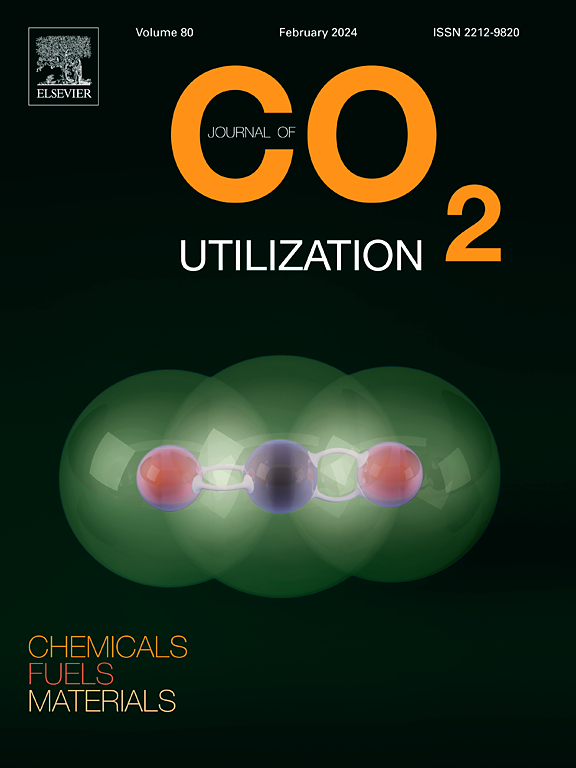Ceria-doped UiO-66-derived carbon–zirconia supported vanadium catalysts for CO2-ODHP: Synergistic effects of MSI tuning, oxygen vacancies, and spillover behavior
IF 8.4
2区 工程技术
Q1 CHEMISTRY, MULTIDISCIPLINARY
引用次数: 0
Abstract
In this study, a series of zirconia-supported vanadium oxide catalysts—VZ (V2O5@ZrO2), VZC (V2O5@ZrO2/C, UiO-66-derived), and Ce-VZC (Ce-doped-V2O5@ZrO2/C)—were synthesized and systematically evaluated for the CO2-assisted oxidative dehydrogenation of propane (ODHP). The incorporation of a carbonaceous framework derived from UiO-66 and the strategic doping of ceria were employed to optimize metal-support interactions (MSI), enhance oxygen vacancy formation, and promote the spillover of key intermediates. A comprehensive characterization strategy—including XRD, FT-IR, HR-XPS, FE-SEM/EDS, BET, H2-TPR, and H2/CO2-TPD—combined with DFT calculations was undertaken to correlate structure–property–performance relationships. The results reveal that Ce-VZC exhibited the highest surface basicity, active site dispersion, reducibility, and oxygen vacancy concentration, all of which translated into superior catalytic performance and stability. DFT calculations confirmed the lowered energy barriers for propane dehydrogenation and CO2 activation in Ce-VZC, while also demonstrating moderated MSI and longer spillover distances of H, O, and CO2 species. Among the catalysts, Ce-VZC achieved the highest propane conversion (19.3 %) and propylene yield (13.9 %) with excellent stability over 600 min of time-on-stream. This work highlights the synergistic effect of ceria doping and carbon integration in tuning MSI, redox properties, and intermediate spillover, offering a promising route toward the rational design of high-performance ODHP catalysts.
二氧化硅掺杂uio -66衍生碳-氧化锆负载的CO2-ODHP钒催化剂:MSI调整、氧空位和溢出行为的协同效应
本研究合成了一系列氧化锆负载型钒催化剂vz (V2O5@ZrO2)、VZC (V2O5@ZrO2/C, uhio -66衍生)和Ce-VZC (Ce-doped-V2O5@ZrO2/C),并对其用于丙烷co2辅助氧化脱氢(ODHP)进行了系统评价。采用UiO-66衍生的碳质框架和铈的战略性掺杂来优化金属-支撑相互作用(MSI),增强氧空位的形成,并促进关键中间体的溢出。采用综合表征策略,包括XRD、FT-IR、HR-XPS、FE-SEM/EDS、BET、H2- tpr和H2/ co2 - tpd,并结合DFT计算来关联结构-性能-性能关系。结果表明,Ce-VZC具有最高的表面碱度、活性位点分散性、还原性和氧空位浓度,具有优异的催化性能和稳定性。DFT计算证实了Ce-VZC中丙烷脱氢和CO2活化的能量势垒降低,同时也表明了H、O和CO2物质的MSI缓和和更长的溢出距离。在催化剂中,Ce-VZC的丙烷转化率最高(19.3 %),丙烯收率最高(13.9 %),在600 min的运行时间内具有优异的稳定性。这项工作强调了铈掺杂和碳整合在调整MSI、氧化还原性能和中间溢出方面的协同作用,为合理设计高性能ODHP催化剂提供了一条有希望的途径。
本文章由计算机程序翻译,如有差异,请以英文原文为准。
求助全文
约1分钟内获得全文
求助全文
来源期刊

Journal of CO2 Utilization
CHEMISTRY, MULTIDISCIPLINARY-ENGINEERING, CHEMICAL
CiteScore
13.90
自引率
10.40%
发文量
406
审稿时长
2.8 months
期刊介绍:
The Journal of CO2 Utilization offers a single, multi-disciplinary, scholarly platform for the exchange of novel research in the field of CO2 re-use for scientists and engineers in chemicals, fuels and materials.
The emphasis is on the dissemination of leading-edge research from basic science to the development of new processes, technologies and applications.
The Journal of CO2 Utilization publishes original peer-reviewed research papers, reviews, and short communications, including experimental and theoretical work, and analytical models and simulations.
 求助内容:
求助内容: 应助结果提醒方式:
应助结果提醒方式:


